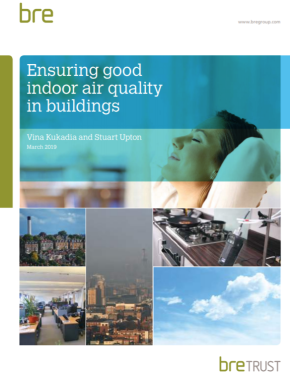Ensuring good indoor air quality in buildings
Ensuring good indoor air quality in buildings was written by Vina Kukadia and Stuart Upton and published by the BRE Trust in March 2019.
According to the United Nations, in 2016, 54.5% of the world’s population was living in urban settlements, with 23%, or 1.7 billion, living in cities with at least a million inhabitants. That is expected to rise to 60% by 2030.
With the growth in urbanisation comes the risk of increased air pollution, which the World Health Organization estimates is the cause of three million deaths globally each year.
While outdoor air pollution can impact the quality of indoor air in buildings, an array of other factors also negatively affect indoor environments and the health of occupants. This is a critical issue given that people living in developed countries typically spend 90% or more of their time indoors, with the most susceptible individuals, such as the elderly and those with pre-existing medical conditions, spending almost all their time inside.
Indoor air quality (IAQ) is complex, with many factors affecting it, including a wide range of pollutants and sources, building types, locations and décor. Exposure to different pollutants can cause health effects ranging from the worsening of asthmatic conditions and skin irritation, to premature deaths caused by heart and lung disease.
This free BRE Trust publication summarises the issues that building owners, designers and facilities managers face when seeking to provide good indoor air quality. It gives an overview of the sources and types of pollutants likely to affect different indoor environments in urban areas, and summarises current regulations, standards and guidance in the UK. It also includes short case studies to illustrate strategies for improving indoor air quality.
Its contents are:
- Introduction.
- Air pollutants and their sources.
- Impact of poor IAQ on health, wellbeing and productivity.
- Indoor air quality standards and guidelines.
- Mitigating air pollutants in the indoor environment.
- Case studies.
- Appendix.
- References.
- Acknowledgements.
Ensuring good indoor air quality in buildings can be downloaded free at: https://www.bregroup.com/bretrust/wp-content/uploads/sites/12/2019/03/Ensuring-Good-IAQ-in-Buildings-Trust-report_compressed-2.pdf
[edit] Related articles on Designing Buildings Wiki
- Air Quality Taskforce.
- Air quality.
- At a glance - Indoor air quality.
- BRE articles.
- BREEAM and air quality.
- BREEAM Indoor air quality plan.
- BREEAM Indoor air quality Ventilation.
- BREEAM Indoor pollutants VOCs.
- Bringing a breath of fresh air to the design of indoor environments.
- Building Research Establishment.
- Clean indoor air for healthy living - New air filter standards.
- Effective ventilation in buildings.
- Health effects of indoor air quality on children and young people.
- Human comfort in buildings.
- HVAC industry defines post COVID-19 changes.
- Indoor air quality.
- Indoor environmental quality.
- Locating ventilation inlets to reduce ingress of external pollutants into buildings: A new methodology IP 9 14.
- The history of non-domestic air tightness testing.
Featured articles and news
Government consultations for the summer of 2025
A year of Labour, past and present consultations on the environment, the built environment, training and tax.
CMA competitiveness probe of major housing developers
100 million affordable housing contributions committed with further consultation published.
Homes England supports Greencore Homes
42 new build affordable sustainable homes in Oxfordshire.
Zero carbon social housing: unlocking brownfield potential
Seven ZEDpod strategies for brownfield housing success.
CIOB report; a blueprint for SDGs and the built environment
Pairing the Sustainable Development Goals with projects.
Types, tests, standards and fires relating to external cladding
Brief descriptions with an extensive list of fires for review.
Latest Build UK Building Safety Regime explainer published
Key elements in one short, now updated document.
UKGBC launch the UK Climate Resilience Roadmap
First guidance of its kind on direct climate impacts for the built environment and how it can adapt.
CLC Health, Safety and Wellbeing Strategy 2025
Launched by the Minister for Industry to look at fatalities on site, improving mental health and other issues.
One of the most impressive Victorian architects. Book review.
Common Assessment Standard now with building safety
New CAS update now includes mandatory building safety questions.
RTPI leader to become new CIOB Chief Executive Officer
Dr Victoria Hills MRTPI, FICE to take over after Caroline Gumble’s departure.
Social and affordable housing, a long term plan for delivery
The “Delivering a Decade of Renewal for Social and Affordable Housing” strategy sets out future path.
A change to adoptive architecture
Effects of global weather warming on architectural detailing, material choice and human interaction.
The proposed publicly owned and backed subsidiary of Homes England, to facilitate new homes.
How big is the problem and what can we do to mitigate the effects?
Overheating guidance and tools for building designers
A number of cool guides to help with the heat.
The UK's Modern Industrial Strategy: A 10 year plan
Previous consultation criticism, current key elements and general support with some persisting reservations.
Building Safety Regulator reforms
New roles, new staff and a new fast track service pave the way for a single construction regulator.


























